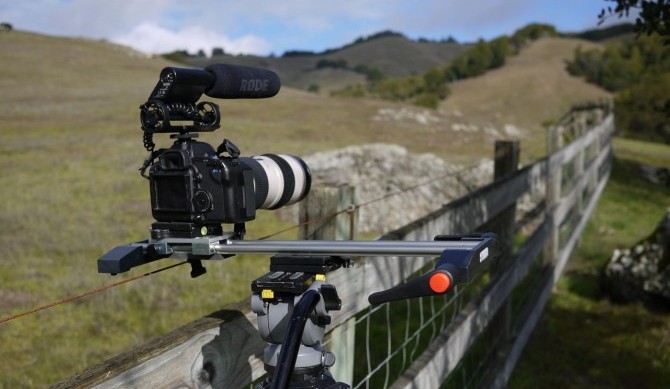To an independent film maker, video is a bad word. Films aren’t supposed to be shot on video cameras. They’re supposed to be shot on, well, film. After all, 35 mm film remains the standard that Hollywood productions have always preferred, and it has a certain aesthetic that video cameras lack. That is, until recently.
You may have noticed that television shows lately have been looking more cinematic. That’s largely because video cameras are no longer limited to the interlaced frames and resolution of a CRT television. Every video camera wishes it looked like film, and with modern HD progressive cameras shooting in 24 frames per second, they’ve gotten pretty close. Tthe biggest aesthetic difference has been in the size of the sensor. A 35 mm film camera captures a certain field of view and a certain amount of light. As any photographer can tell you, the size of the sensor is far more important than the amount of megapixels. The larger the sensor, the more light and depth of field is possible, creating a more dramatic and immersive image. A smaller sensor, such as the third of an inch size found in traditional video equipment, captures less light and results in a flatter image.

Various sensor sizes compared to 35mm
Sure, film giant Panavision created digital cinema cameras with 35 mm-sized sensors, but at an estimated $500k price tag, you’re better off shooting with actual film. It actually took the prosumer digital photography market to bring affordable 35 mm-sized digital sensors to the masses. You see, digital SLR cameras are designed to replace film for photography. In order to sell cameras like Canon’s flagship 5D to photographers, they needed to have a 35mm sensor and be able to compete with the price of shooting with traditional film.

The Panavision Genesis was the first digital video camera to offer a 35mm sensor. If you are willing to cough up $500k
But wait just a minute, when you have a digital 35 mm sensor, the difference between recording stills and video is minimal. Capture 24 of those stills per second and throw it into a video codec, and suddenly this still camera can record more cinematic looking footage than video equipment that costs several times as much.
It took a while for the industry to recognize the potential here. Professional photographers weren’t interested in video modes, dismissing it as a gimmick normally found on consumer point and shoot cameras. And professional videographers laughed at the idea of using a still camera in movie mode. Slowly, DSLR cameras began to show up in the hands of cinematographers such as Vincent LaForet and Phillip Bloom, who praised the capability and quality of the image at this price point. Bloom was even given the unique opportunity to demonstrate a Canon 5D and 7D for George Lucas at his Skywalker Ranch. Apparently Lucas was so impressed that he called in Quentin Tarantino to come see, who described the footage as “Epic” and “William Wylersesque”. And thus, the DSLR revolution began, blurring the lines between videographers and film makers.
[yframe url=’http://www.youtube.com/watch?v=uY055QEPM18′]
Soon, DSLR footage was found on the big screen in films like Black Swan and more recently Lucas’ own Red Tails, not to mention found all over television, including an entire episode of FOX’s House.
So, did DSLR kill the video camera? Not exactly. A DSLR is not necessarily a worthy replacement in many situations. An ENG or prosumer video camera can offer a heavier build with a weighted center of gravity to reduce camera shake, have easily accessed controls and meters helpful for shooting video, and balanced XLR microphone inputs with the ability to monitor live via headphones, not to mention smooth servo-controlled zoom and autofocus lenses. To a videographer, most if not all of these features are indispensable.
DSLR cameras are, after all, designed primarily to shoot stills. The size of the camera tends to exaggerate even the slightest camera shake, and the lack of professional audio means that an external audio recorder is often required to synchronize with your video footage in your editing suite. Critics of the technology are also quick to point out that the heavily compressed video codec and image artifacts make color correction and shooting certain types of patterns messy, not to mention the wobble and skew from a rolling shutter CMOS sensor. In the wrong hands, DSLR footage can look downright ugly. But in the hands of a talented cinematographer, the resulting footage can be absolutely breathtaking.
Now, if you follow the camera industry, you might be asking “what about large sensor video cameras?” After the DSLR revolution shook up the video industry, manufacturers like Sony and Panasonic started offering large sensor video cameras with interchangeable SLR lens mounts. Essentially, this was a DSLR chip inside of a larger video camera. While there are quite a few advantages to using one of these over a DSLR camera, the bottom line here is that DSLRs brought cinema-quality video to the masses at a fraction of the cost, and they are preferred by many videographers and independent film makers. Creativity shouldn’t be limited to only those who can afford expensive equipment.
As French film maker and writer Jean Cocteau once said “Film will only become an art when its materials are as inexpensive as pencil and paper.” While a good DSLR can set you back a bit more than pencil and paper, the tools are now more accessible than ever before.


Nice post, re-invigorates me to pick up my Panasonic GH1(hacked to shoot 24fps at 1080p) and gear up!
Nice- GH1 is a really nice little camera. But the M4/3rds mount needs some constant aperture zooms with IS. Maybe when these new X lenses come out.